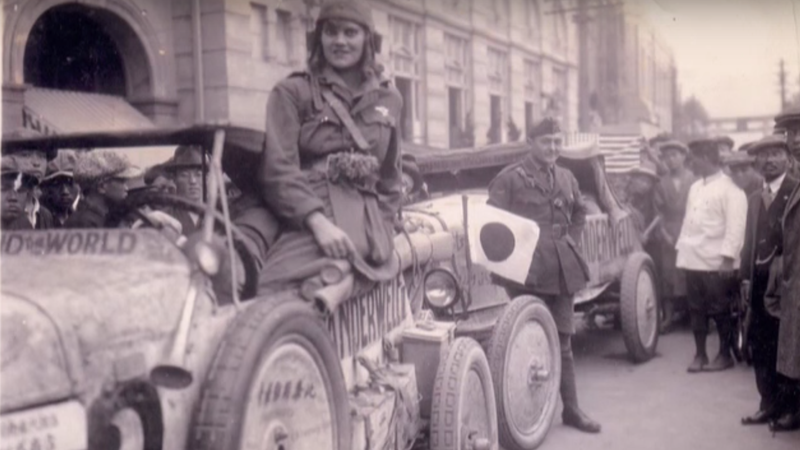
Aloha Wanderwell. The name itself sounds destined for adventure, and there was adventure aplenty in the 1920s for a young woman eager to see the world. Back then, before the jet age, the world outside your front door was still shrouded in mystery, more than reason enough for the Winnipeg-born Wanderwell to sign up, at the age of sixteen, for an expedition around the world.
Wanderwell was born Idris Galcia Hall and was a hard-to-tame six foot tomboy, restless and inspired by the fantastic tales of travel she read in her childhood books and by her family’s relocation in Paris. So, according to her memoir Call to Adventure, in 1922 an ad calling for “Brains, Beauty, & Breeches — World Tour Offer For Lucky young woman… Wanted to join an expedition… Asia, Africa…” was exactly what the sixteen year old was after. She immediately sent in an application to join the around-the-world expedition led by “Captain” Walter Wanderwell.
It was on her journey that she became Aloha. Captain Wanderwell, who had been capturing headlines with his Million Dollar Wager—a round-the-world endurance race between two teams in Ford Model Ts to see who could visit the most countries—met Idris in Paris and, charmed by her charisma, immediately took her on as a translator, driver, and secretary.
Each endurance team was funded by selling souvenir pamphlets, public speaking events, and screenings of films that were shot and edited on the road. Some money came in from Ford, who appreciated the good press the Wanderwells provided, but everything else had to come from their own pockets. Adapting herself to the grueling trip, Aloha Wanderwell became the star of the expedition. She was no longer just a translator; instead, she adopted the roles of actress, photographer, cinematographer, film editor, salesperson, vaudeville performer, interpreter, negotiator, and mechanic — alongside whatever else needed doing.
On that trip, Aloha traveled through 43 countries on four continents. In her memoir, she recounts French battlefields, Mussolini’s Italy, mobs in Germany desperate for food in the wake of WWI, camping beneath Egypt’s Great Sphinx, witnessing Jews working to build a new nation in Palestine. She suffered dehydration in the deserts of Sudan, was granted the title “Honorary Colonel” in the Red Army of Siberia, and prayed in Mecca. Their Model-T used kerosene as gasoline, and Aloha crushed bananas to grease the differential, turned elephant into engine oil. In the mud flats and rivers of India, she helped hitch the Model-T to oxen, and when the civil feuding of China made finding fuel impossible, Aloha was right there with the laborers pulling the car for eighty miles.
Advertisement
Despite, or perhaps because of, the dirt and grime and grueling travel, Aloha and Captain Wanderwell fell in love and married when they reached the American leg of their journey. In 1929, after completing the initial globe trek, the two released a documentary titled With Car and Camera Around the World, which vaulted the Wanderwells to international acclaim.
The team against which Captain Wanderwell was competing in the Million Dollar Wager was not as prolific in documenting their travels. But, surprisingly, it was headed by Captain Wanderwell’s first wife, Nell, a Broadway chorus girl that he married in Alabama and divorced after he met Aloha. The competitive nature of the wager fizzled out alongside the romance between Nell and the Captain, but due to Aloha’s dedication to capturing her own journey, it can be said that she and the Captain won the challenge.
But Aloha’s thirst for adventure was not yet slaked. After learning how to fly a German seaplane affectionately named “Junker,” she and Walter set off once more for a journey deep into the Mata Grosso region of the Amazon basin but didn’t quite make it; their plane went down in uncharted jungle territory after running out of fuel. The plane was their sole means to get home; Aloha had to remain with a local indigenous tribe while Walter attempted to find civilization in order to attain replacement parts.
Advertisement
Although Aloha and the natives didn’t speak the same language, Aloha eventually befriended them to the extent that they trusted her to create a careful documentation of their lives. What Aloha didn’t realize at the time was that this was the first ever filmed record of the Bororo tribe of Brazil, a hugely important anthropological document that captured months of the tribe’s activity as Aloha waited for Walter to return. Today, Flight to the Stone Age Bororos can still be found in the Smithsonian Institute’s Human Studies Archive.
Unfortunately, the journey for Walter and Aloha ended shortly after the couple returned to California. Walter was murdered on the couple’s yacht in Long Beach, and the police were never able to solve the mystery, despite the watchful gaze of the worldwide media who were shocked to find out that a man of adventure could lose his life so close to home.
Advertisement
Aloha did remarry, this time to a man named Walter Baker who had once been a cameraman for Work Around the World Education Club, an organization founded by Captain Wanderwell to help fund their travels. He did his best to aid Aloha in her travels and build her reputation as The World’s Most Traveled Girl, but Wanderwell’s notoriety declined after the 1930s, as the world turned its attention to another war.
But Aloha Wanderwell crushed records and made incredible accomplishments for a woman of her era. She was the first to cross India and Cape Town to the Nile, the first woman to fly Brazil’s Mato Grosso, and the first woman to drive around the globe, journeying 380,000 in the 1920s. She fought as a member of the French Foreign Legion and joined the Women’s International Association of Aviators.
Advertisement
Wanderwell passed away in 1996, but the impossibly true tale of her exploits will live on after her as an inspiration for anyone who lusts to know more about what the world has to offer.













